The recent revolution in technology has made graphics incredibly powerful compared to five years ago. This rapid growth far exceeds Moore's Law, which predicted that technology would only double in power within that timeframe. Now, computers can be a million times faster within a decade, thanks to NVIDIA's RTX (real-time ray tracing GPUs), allowing for the near-instant creation of photorealistic images.

Ray tracing is a technique that makes computer images look incredibly real by simulating how light reflects and refracts off objects. This technology has led to a dramatic shift in rendering techniques. Before ray tracing emerged, rasterization-based rendering techniques dominated, but they couldn't create images with the same level of realism.
Benefits of Ray Tracing
Ray tracing simulates rays of light from the observer's eye, passing through the 3D space and interacting with surface objects. Each ray can be reflected, refracted, or absorbed, creating highly realistic lighting and shadow effects. This technique accurately produces complex lighting effects such as reflections, refractions, and soft shadows.
Breakthrough of RTX GPUs
The advent of NVIDIA's RTX GPUs, starting around six years ago, made real-time ray tracing feasible. Previously, ray tracing could only be performed in post-production processes or for applications that didn't require real-time processing due to its extensive computational demands. With RTX, GPUs can execute ray tracing instantly, reducing the time needed to create detailed images from several days to just a few hours, or even seconds in some cases.

Impact of AI
Integrating AI into this GPU technology has made previously distant goals in computer graphics achievable. AI is used to optimize the ray tracing process, minimizing unnecessary calculations and speeding up processing. This not only enhances performance but also improves image quality, making scenes in games and applications more lifelike than ever before.
The Dark Side of Powerful Technology
However, this gigantic leap in technology is not without its dark side. The rapid development of AI and related technologies can lead to unforeseen consequences. One major concern is the over-reliance on technology, causing humans to lose some degree of control and creativity. Moreover, the use of AI in various applications raises questions about privacy, security, and ethics.
Conclusion
Ray tracing has elevated the digital graphics industry to a new level, opening up unprecedented possibilities for creating photorealistic images. The combination of RTX GPUs and AI has turned what once seemed impossible into reality, providing users with exceptional experiences. However, like any powerful technology, it requires careful consideration of its dark sides and potential consequences to ensure that this development serves humanity's best interests.